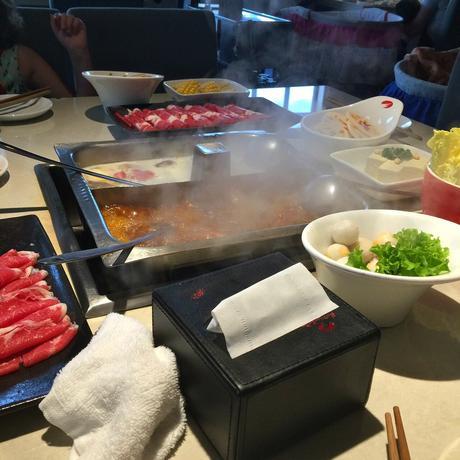
“All the girls love hot pot!” he said, grinning at me like a Cheshire cat! The girls around him nodded enthusiastically in agreement. I was a little surprised – at the time, still rather new to Xi’an – because we were talking about ‘favourite’ foods (as I’ve since discovered is often the prime topic of conversation amongst my Chinese friends). Instantly those western temptations like chocolate, cheese and pizza flashed across my mind in all their gooey, scrumptious glory.
But this is China and in Xi’an, noodles reign supreme; hot on its heels is Huo Guo – known as Hot Pot to you and me! (Which just for the record, also incorporates those stringy, slippery suckers!)
“What about you?” they pressed! “Do you love hot pot?” I had to think about it for a few seconds…not wanting them to lose ‘face,’ I knew I had to answer carefully. “Yeh!” I said (as convincingly as possible). “Aside from my all-time-favourite, Dim Sum, Hot Pot is probably up there as one of the more palatable Chinese dishes, I’ve tasted.” (They all let out a relieved sigh!)
But to be honest, for me, hot pot is more about the fun!
Think bubbling pots of broth in the centre of your table where you choose your own ingredients to boil yourself! I’ve even had my own mini hot pot beside me at the table. (Just don’t put your phone down on said hot plate, hiding under the tablecloth)!
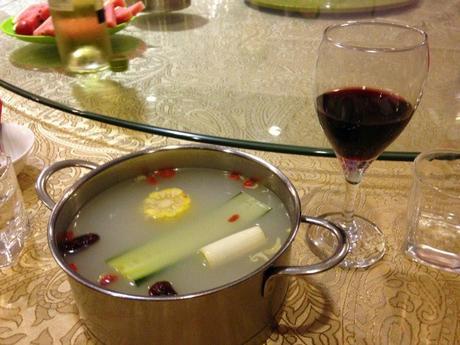
I’ve fished out my fair share of tasty (and often unrecognisable) morsels from these sizzling cauldrons, many so spicy they feel like they could actually blow your head off. (Or as you’ll see below, clear those sinuses!) Thankfully many large hot pots can be split in two, so you can opt for a milder version on one side! (And of course the broth of choice changes from north to south, east to west!)
But perhaps my most memorable occasions have been at the renowned HaiDiLao. Here, it’s not just a journey for the taste buds, it’s an experience you surely will not forget!
HaiDiLao is famed for its service as well as it’s food in China and in my neighbourhood the restaurant takes up around six floors. It’s always busy! At the bottom near the entrance to the lift, (to my surprise) is a makeshift nail/massage salon! Yep, it’s that popular, the queues are often lengthy, so why not have a manicure for free while you wait!
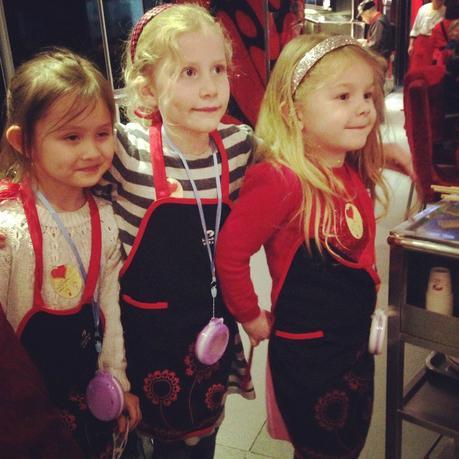
There’s also a kid’s playroom… even better, the staff take it upon themselves to look after your little ones while you dine four floors up! They even give the little critters gifts! (See above – musical gifts swinging from necks!)
Upstairs, prepare to get steamy. (Who needs a facial, no wonder the girls love it!)Wear your hair tied back ladies..and if you forget a hair tie, don’t worry HaiDiLao has them on standby, not to mention aprons and phone covers!!

For a foreigner like me, ordering is a little like “Eeny, meeny, miny moe”…but at least there are pictures. My local haunt uses iPads, so it’s a case of choose and swipe! So, you might get Tofu instead of Potato, but it’s all fun and games. The crucial thing is to choose the right flavour for your broth especially if you’re up north where most are swirling with hot chilli!
There’s also some fantastic entertainment just in case you forget where you are! 😉
Don’t worry though, the guys over at Spoonhunt, who’ve launched an App that helps you find the best restaurants in China with English menus, have nailed it with this special guide for Mint Mocha Musings readers.
Hot Pot eat your heart out!

When things cool down, especially up north, where we’ve already had a good dolloping of snow, Hot pot starts to look like a great stomach warming option. Unless you’re an experienced hot pot connoisseur, you may be intimidated by the wide variety of broths, ingredients, styles, and shapes hot pot can come in. This guide will help you through the types and strategies to maximize your hot pot experience.
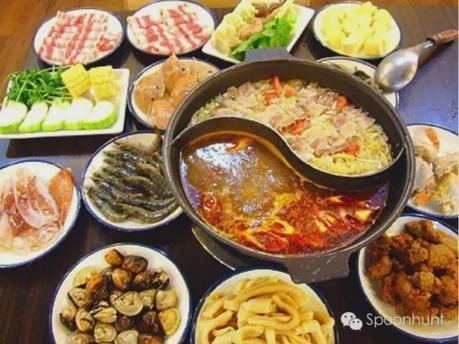
Chongqing Spicy Hot Pot (重庆麻辣火锅)
Specialty: Spiciness
Broth: Sichuan peppers and Meat Stock
Popular Ingredients: Beef, Lamb, Tofu, Green Vegetables, Sprouts, Noodles
This is the most popular form of hot pot in China. The specialty comes from the Sichuan peppers in the broth that will completely numb your mouth. Chongqing hot pot comes in a few different forms, such as Yuanyang (鸳鸯) hot pot and Qiaotou (桥头) hot pot, where the spicy broth and the mild broth for cooking the food are separated. You can enjoy both spicy and plain broths which is perfect for a large group with different preferences. It’s a good way to clear the sinuses and make you sweat during the winter!
One of the most popular Chinese chain restaurants that features the Chongqing hot pot is HaiDiLao 海底捞which you can find by searching for “HaiDiLao” on the Spoonhunt App.
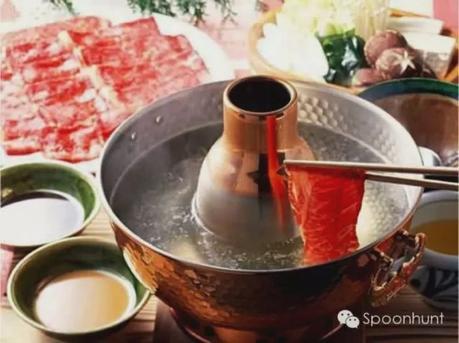
Beijing Style Lamb Hot Pot (北京羊肉涮锅)
Specialty: Lamb
Broth: Bone Stock
Popular Ingredients: Lamb, Frozen Tofu, Chinese Cabbage, Mushrooms, Glass Noodles, Sesame Sauce
Also known as Mongolian style, this hot pot originates from the Qing Dynasty, focusing mostly on eating lamb. The broth is not spicy, so it’s perfect for those who can’t handle the Sichuan peppers. The lamb is sliced so thin that when you take it out of the boiling broth, it just melts in your mouth. The lamb cooks really quickly and comes with some peanut or sesame dipping sauce for extra flavor.
A popular Chinese chain restaurant Little Sheep Hot Pot 小肥羊 specializes in this style and can be found in virtually every city in China. You can search “Little Sheep” on the Spoonhunt App.

Cantonese Congee Hot Pot (广东粥火锅)
Specialty: Thick Soup and Seafood
Broth: Congee (rice porridge) and Meat Stock
Popular Ingredients: Fish, Prawn, Pork, Pan-fried Noodles, Tofu, Fried Dough Sticks (you tiao)
Congee is rice porridge that Cantonese people love because of the believed health benefits it has on digestion, so they mixed it together with soup broth to get boiling congee hot pot. Typically, seafood is cooked in congee hot pot since Southern China has a long stretch of coast and fresh seafood, but like the other hot pots, you can eat meat and vegetables as well. The broth is thickened but not as thick as you might expect it to be given that Congee is a major ingredient. The rice is actually cooked until broken down so that it won’t stick to the bottom of the pot and burn. However, this special broth is used to bring out the freshness of its ingredients and is kept hot throughout the meal.
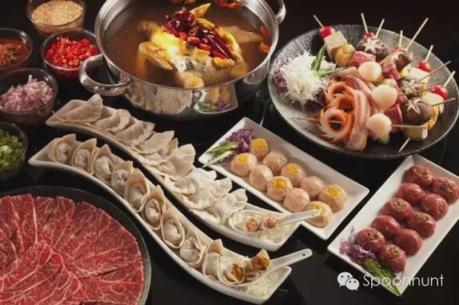
Macau Bean Scoop Hot Pot (澳门豆捞)
Specialty: Meatballs
Broth: Chicken Stock
Popular Ingredients: Beef, Pork and Fish Meatballs, Glass Noodles, Dumplings
This hot pot actually comes from Hong Kong. The specialty of this hot pot comes from the quality of its ingredients and meatballs made out of beef, fish and shrimp that you can cook. The Chinese name sounds a lot like “everyone scoops,” implying that everyone eating this hot pot will scoop up luck and fortune. Plus, the meatballs are easier to scoop out of the pot then pick out with chopsticks. Hong Kong style hot pot comes with a variety of ingredients you can mix together to create your own dipping sauce for when the meatballs are ready to eat.
You can search the Spoonhunt app for “Doulao” to find the nearest Macau Bean Scoop restaurant.
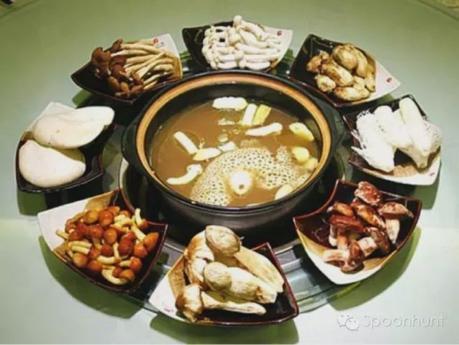
Yunnan Flavor Hot Pot (云南滇味火锅)
Specialty: Vegetarian (Mushrooms)
Broth: Mushroom and vegetable stock
Popular Ingredients: All kind of Mushrooms, Tofu, Sprouts, Rice Noodles, Chinese Cabbage
Heads up vegetarians, this hot pot is for you! Yunnan flavor hot pot focuses on the use of fresh vegetables both as a base and dipping ingredients. It’s a very special and seasonal type of hot pot based on the freshness of the vegetables. In Kunming there is an entire street dedicated to serving this hot pot, and each place uses their own selection of exotic mushrooms. The broth is made from a variety of wild or planted mushrooms and utilizes a large number of mushrooms main ingredients to cook. When dealing with wild mushrooms, let your waiter/waitress take care of the cooking as they are experts in making they are thoroughly cooked and no longer toxic. You will never know how many different kinds of mushrooms there are until you try this hot pot.
Spoonhunt’s Top Tips for Eating Hot Pot
Pre-meal
- If you drink a little bit of fruit juice or a yogurt drink before a spicy hot pot, your stomach will manage a little bit better.
- Remove any items of clothing that could get in the way, and if you have long hair make sure it won’t get into the pot by accident.
- Ensure that you have the proper utensils including clean chopsticks, ladles, napkins, plates, bowls and aprons if necessary.
- Make sure your phones aren’t on the table near the pot or your plates, as hot pot soup can easily splash onto it.
During the Meal
- Make sure you have a steady boil before you put anything in the broth, otherwise you might undercook your meat. Meatballs will float when they’re done.
- While waiting for the broth to boil, make your dipping sauces. It takes a while to boil, so use that time to come up with a good dipping sauce. Make sure to mix it thoroughly.
- Be aware of what your chopsticks touch. If they just touched raw meat, dunk them in boiling broth. Don’t touch raw meat and then your cooked meat right after!
- Cook the seafood and meats first before the vegetables because leafy vegetables will soak up more of the great oils and broth flavor.
- The tofu will be molten hot when it first comes out, so don’t rush into eating it.
- Don’t splash. This isn’t the community pool; the boiling broth can easily burn you. Be careful.
- If you’re eating Chongqing Hot Pot, DON’T EAT THE PEPPERCORNS! They will instantly numb your mouth and you’ll have a bad time.
Pretty good tips thanks to Spoonhunt! Yeh, especially about those peppercorns!
So if you’re travelling to China, you know you need to do yourself a favour and make sure you get hot and sweaty with the ultimate Chinese food experience!
This is Hot Pot!
This is China!
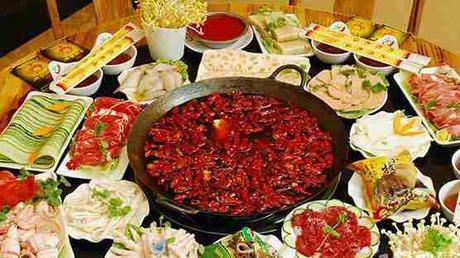
**Oh and if you live in China (or even if you don’t) and want to know the best ingredients to buy to cook up your own hot pot at home, look no further:
Meats
Sliced Beef, Lamb and Pork (肥牛/肥羊/五花肉)
The most basic but still incredibly delicious meat you can order for any of the hot pots we’ve mentioned. You can order beef, chicken, pork or lamb, but beef and lamb are must tries. It’s typically sliced paper thin so that it will cook quicker while still having enough surface area to absorb the delicious oils in the broth. When the meat is ready to eat, it will literally melt in your mouth.
Meatballs (肉丸)
Meat for hot pot can also come in meatball form. They are quite easy to cook as they only take 4–5 minutes and will float back to the surface when they are ready to be eaten.
Fried Pork (小酥肉)
It may seem counterintuitive to put something already cooked, let alone fried, into the hot pot to cook, but you can put fried pork, called 小酥肉, into the hot pot to get a little bit more flavor from the broth, especially spicy broth. Since the meat is already cooked, you only need to stick it into the broth for a few seconds. Any longer and it will get soggy.
Seafood
Sliced Fish Fillet (鱼片)
Whether it’s catfish (鲶鱼), mullet (鲻形目), snakehead fish (黑鱼), cod (鳕鱼) or any other type of fish that might be on the menu, sliced fish fillets are a classic seafood addition to any hot pot. The pieces of fish are sliced then to make cooking them in the boiling broth much easier. Fish tend to be featured more in the southern China-styled hot pots, like in Macau, Hong Kong and Guangdong, but can be ordered at any hot pot restaurant.
Squid (鱿鱼)
Squid for hot pot comes in two different forms: body and tentacle. Fresh squid has a spongey texture to it and is either left as the body or separated into tentacles. Squid is good at soaking up the delicious flavors of the hot pot broth, so it’s important to pick the right kind of broth to increase flavor. The body of the squid is usually the softer meat while the tentacles are chewy. Squid is naturally salty, and it’s important to find the right dipping sauce to complement the taste and texture.
Minced Shrimp Slide (虾滑)
Shrimp slide is a special kind of seafood ball you can put in hot pot. The shrimp is minced very fine and mixed with water and flour to get a thick gooey paste. It’s usually served in a scoop instrument with spoon to make your own fish balls from it. All you have to do is slide balls of the shrimp from the scoop into the hot pot using the tool, hence the name. Depending on the restaurant, they can also come premade or in a cake paste to make your own. When the balls are ready, they will float and be very soft.
Vegetables
Lotus Root (藕片)
The first time I saw lotus root in China, I seriously thought it was pig snout. But it’s not. It’s a root vegetable, and quite delicious I might add. It’s a good substitute for potato. It’s very starchy and crisp when raw, but when cooked in the boiling hot pot, it becomes a little bit softer and flavorful. It absorbs the flavors from the hot pot very well but will sink to the bottom, so you’ll have to fish it out. Depending on how crispy or soft you want your lotus root, it can take longer to cook than most vegetables.
Sprouts (豆芽)
Sprouts are an easy, cheap and light vegetable addition to any hot pot. They usually come in large quantities (a pile) on a plate that might seem intimidating at first, until you remember how light they are. The arrive at your table cool and crisp, but when you shovel them into the boiling broth, they will go limp and be ready to eat fairly quickly.
Baby Cabbage (娃娃菜)
We all know the huge Chinese cabbages that are oddly worshipped. I’ve even seen the huge jade cabbage (art I guess). This is the smaller version of that. Baby cabbage is hearty leafy green vegetable that is worth giving a shot. Unlike spinach, baby cabbage has thicker stems, so it takes a few minutes longer to cook. But they still absorb lots of soup and spice from the broth with their large leaves, so they are best left for the end of the hot pot. When they are cooked, they come out a little bit sweet.
Mushrooms
Oyster (Ping Gu) Mushrooms (平菇)
The Ping Gu mushroom is a very common mushroom found in a lot of Asian cuisines for soups and sauces. It is called the Oyster Mushroom because the cap fans out like the shellfish it’s named after. Chinese people love adding Ping Gu mushrooms to their hot pot because of its taste and health benefits. While the taste is mild, it’s fairly sweet and serves as a good replacement for meat. It is also linked to lowering cholesterol, blood sugar and blood pressure.
Golden Needle Mushrooms (金针菇)
Golden Needle Mushrooms, know as enoki in Japanese, are a must have in any hot pot. These long, thing white mushrooms are absolutely delicious, especially in the chili soup of Chongqing Spicy Hot Pot. They have a crisp texture, even when soaked. You know they are ready to eat when they have wilted from the soup, which usually only takes 30 seconds to a minute. They are high in antioxidants and are believed to be linked to lowering your risk of cancer.
Black Wood Ear Mushroom (黑木耳)
While not very popular in Western Cuisines, the Black Wood Ear Mushroom thrives in Chinese dishes due to it’s medicinal qualities. It’s use dates all the way back to the Tang Dynasty (618 to 907). This mushroom has more of a soft, jelly-like consistency and is thought to cure colds and fevers. While not edible raw, you can cook it in the soup for a just a few minutes. Black Wood Ear Mushrooms don’t have much taste themselves, but they soak in all the flavors of the soup, so it’s important to pick a flavoursome broth for hot pot.
Tofu
Soft Tofu (嫩豆腐)
The most common type of tofu that everyone probably knows about is Soft Tofu. It is undrained and unpressed so it contains the highest mositure content, which is what makes it so soft. Even blunt chopsticks will slice right through it. The bland tofu absorbs some of flavor in hot pot, so the soup and sauces are extremely important. Since tofu is already cooked, you just warm it up in the hot pot, making it gooey and delicious. Be careful, it will be molten hot.
Frozen Tofu (冻豆腐)
When soft tofu gets frozen, the moisture crystalizes and the tofu turns yellow-ish. While it is just frozen soft tofu, it has a completely different taste and texture. Since the moisture is frozen out, it reabsorbs a lot of water from the hot pot broth. Unlike the soft and gooey fresh tofu, frozen tofu gets the hot pot flavors embedded within its spaces and has a much more bouncey feel to it.
Fried Tofu Puffs (油豆腐)
These deep fried tofu puffs are made by cutting tofu into squares and deep frying it. If the water gets squeezed out before getting fried, they will come out light and airy and float in hot pot. If the tofu is frozen before being deep fried, it will be heavier in the middle and sink in hot pot. Either way, they’re deliciously crispy on the outside and the broth will simply add flavor.
Noodles
Cellophane Noodles (粉丝)
These see-thru noodles go by many names in English: glass noodles, crystal noodles, Chinese vermicelli, and bean thread noodles. Regardless the name, these clear noodles are a great add to any hot pot. They are typically quite thin, and when they are pulled out of the soup, they become slippery and spongey. When placed in clear soup, they look like they basically disappear. They are made with mungbeans and water, so they don’t have a lot of taste themselves, but they absorb a lot of flavors from the sauce and soup.
Potato Noodles (土豆粉)
Potato Noodles are used in a lot of different Chinese noodle dishes, so odds are you’ve had them before. But you’ve probably never seen them uncooked before. When they come to the table, they are brittle and stiff and get softened by the boiling soup. Fully cooked, they are very soft, chewy, whiter and thicker than the glass noodles. They are known for their savory natural taste and aren’t as greasy as other noodles. They’re a little bit heavier than some of the other noodles, but they are an old school classic (going back to the Ming Dynasty).
Broad Noodles (宽粉)
These wide noodles are actually made from sweet potato. Their width varies based on region and chef, but all of them get slippery and oily when cooked in hot pot broth (due to the special type of sweet potato flour used). They are naturally sweet but are great at retaining the flavor of the broth and sauce they are dipped in. Sesame, soy and peanut sauces are the best for this type of noodle, as they complement the natural sweet taste.
Happy Hot Potting!

